Kiss Me Kate 3D Blu-ray Movie
HomeKiss Me Kate 3D Blu-ray Movie 
Blu-ray 3D + Blu-rayWarner Bros. | 1953 | 110 min | Not rated | Mar 03, 2015
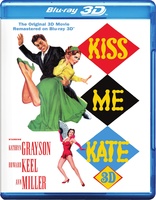
Movie rating
7.3 | / 10 |
Blu-ray rating
| Users | 4.1 | |
| Reviewer | 4.5 | |
| Overall | 4.1 |
Overview
Kiss Me Kate 3D (1953)
When two squabbling formerly married actors are cast as squabbling Renaissance romantics in a musical based on The Taming Of The Shrew, life imitates art, and art imitates life. Thrown in a pompous U.S. Army general and a pair of song-and-dance gangsters trying to collect on a gambling debt, and the result is backstage chaos -- with a musical flair.
Starring: Ann Miller, Kathryn Grayson, Howard Keel, Tommy Rall, Keenan WynnDirector: George Sidney (II)
| Musical | Uncertain |
| Romance | Uncertain |
| Comedy | Uncertain |
Specifications
Video
Video codec: MPEG-4 MVC
Video resolution: 1080p
Aspect ratio: 1.78:1
Original aspect ratio: 1.75:1
Audio
English: DTS-HD Master Audio 5.1 (48kHz, 24-bit)
French: Dolby Digital Mono
Spanish: Dolby Digital Mono (Spain)
Subtitles
English SDH, French, Spanish, Korean
Discs
50GB Blu-ray Disc
Single disc (1 BD)
Blu-ray 3D
Playback
Region free
Review
Rating summary
| Movie | 5.0 | |
| Video | 4.0 | |
| Audio | 4.5 | |
| Extras | 2.0 | |
| Overall | 4.5 |
Kiss Me Kate 3D Blu-ray Movie Review
Reach Out and Kiss Me
Reviewed by Michael Reuben March 5, 2015One of the glories of American musical theater, Kiss Me Kate was the biggest hit of songwriter Cole Porter's career. Even after Broadway and popular music parted ways, songs from Kate like "Wunderbar" remained familiar standards. The book by Samuel and Bella Spevack drew from an impeccable source by borrowing Shakespeare's The Taming of the Shrew to tell the story of a quarreling troupe of actors mounting a musical version of the Bard's famous comedy. Half the songs are about the actors' romantic tribulations. The rest are Cole Porter's musical riffs on Shakespeare's characters—a task at which Porter proved so adept that it's sometimes hard to separate his version from Shakespeare's. Kiss Me Kate has remained a favorite among amateur players, local theater companies and even high school drama clubs for its good humor, lively score and happy ending. MGM's 1953 filmed version, directed by George Sidney (Bye Bye Birdie and Viva Las Vegas), had the distinction of being filmed in stereoscopic 3D, and it was widely shown in that format in major U.S. cities, as well as in London. Watching it in 2D, you can tell at once that director Sidney staged numerous scenes with an awareness of the third dimension, as actors fling props and themselves at the audience. Until now, though, Kate has only been available in "flat" presentations. Warner's MPI has restored the 3D version, which is presented on Blu-ray with an alternate 2D version. The results are a revelation.
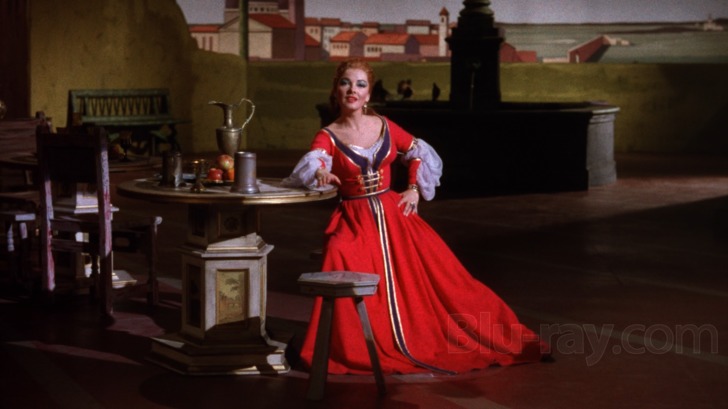
Kate's script by screenwriter Dorothy Kingsley (Seven Brides for Seven Brothers) is mostly faithful to the stage musical, which already provides plenty of cinematic potential in its division between the performances being conducted on stage for the public and the backstage feuds that keep threatening to derail the show. Kingsley adds an interesting wrinkle by giving Cole Porter himself (Ron Randell) a small role as the show's author and explicitly naming the show-within-a-show "Kiss Me Kate". This allows the film to open in the New York apartment of director and star Fred Graham (Howard Keel), who intends to star as "Petruchio" and wants to cast the beautiful and talented Lilli Vanessi (Kathryn Grayson) as "Katherine", the shrew who must be tamed. (Grayson and Keel were a well-known duo from their previous on-screen pairing in 1951's Show Boat.) Fred and Cole have invited Miss Vanessi to join them so that she can hear the new score. The problem is that Fred and Lilli were divorced a year ago, after a tempestuous marriage that is the stuff of legend. Married as starving young actors, they rose to prominence together while arguing about, well, everything. Lilli arrives primed for battle, and in no time she has provocation, as Fred's latest girlfriend, Lois (Ann Miller), bursts in wearing her cabaret costume and clearly knows her way around the apartment (which used to be Lilli's home). But then Lilli drops a bombshell of her own: She's engaged to be married to a wealthy cattle baron, Tex Callaway (Willard Parker), and she's leaving the theater behind. Still, Fred knows how to push his ex-wife's buttons. Before the evening is over, Miss Vanessi has joined the cast of "Kiss Me Kate". On stage, Kate opened with one its signature numbers, "Another Op'nin', Another Show", which did not survive the transition to the screen except as part of the orchestration. Kingsley's revised opening gives Fred and Lilli a chance to establish their true relationship with the first rendition of "So in Love", which will be reprised later in the story. It also allows the film to accommodate the Act Two opening, "Too Darn Hot", which Lois performs to impress Cole Porter and Fred. As performed in the original stage musical by Fred's African-American dresser, it would never have fit into the film's narrative, but as an impromptu rendition in Fred's apartment, the song becomes a showcase for Ann Miller—after which Fred has to tell a crestfallen Lois that the number has been "cut". Thus does Kingsley slip a great song into the film that would otherwise have had to be dropped. From this point onward, the movie of Kate largely follows the play, with the exception of the famous "eleven o'clock" number, "Brush Up Your Shakespeare", which has been moved to an earlier point and also trimmed to eliminate lines deemed too sexual for the standards of the era. (The same primness also required that Lilli's preferred insult to Fred—"Bastard!"—be changed to "You louse!") During rehearsal, Fred and Lilli rekindle their romance as they reminisce over old times ("Wunderbar"). Meanwhile, Lois, who is playing "Bianca", the younger sister of Lilli's "Katherine", worries endlessly about her true love, a young actor named Bill Calhoun (Tommy Rall), who is playing "Lucentio", the suitor who eventually marries "Bianca" in the show-within-a-show. Bill has a gambling habit, and he's just lost two thousand dollars to a major gangster. No worries, though—he signed Fred's name to the marker. Lois is aghast ("Why Can't You Behave?"). Soon enough, a pair of hoods straight out of Damon Runyon arrive to collect the debt. Their names are Lippy and Slug, and they're played by Keenan Wynn and James Whitmore in scene-stealing performances, both backstage and eventually in front of the theater audience, where the two thugs find themselves dragged into the action (in tights!). The temporary truce between Fred and Lilli erupts into full battle, when the leading lady realizes mid-scene that the opening night bouquet she thought was sent to her by Fred was actually meant for Lois, and a critical scene between "Petrucchio" and "Katherine" descends into blows and ad libs. The crowd goes wild. Amidst the ensuing chaos, the company manages to struggle through Shakespeare's tale, supported by Cole Porter's artful lyrics. "Bianca" announces her willingness to accept any of her three suitors ("Tom, Dick or Harry"), while "Katherine" insists she wants none at all ("I Hate Men"). "Petrucchio" announces his intention to marry for money ("I've Come to Wife It Wealthily in Padua"), proceeds to woo Katherine—to no effect—with sweet nothings ("Were Thine That Special Face"), and eventually finds himself yearning for his former days as a bachelor ("Where Is the Life that Late I Led?"). Between scenes Lilli pleads anew for her fiancé, Tex, to whisk her away from the "hell" of show business, and Lois reassures Bill that, despite her dalliance with Fred, it's Bill she really loves ("Always True to You in My Fashion"). Before everything miraculously works out in both the play and the movie, Kiss Me Kate features a magical and, as it turned out, historic dance performance by Ann Miller's "Bianca", her three suitors and two women from the chorus, which is performed to a song, "From This Moment On", added specially for the film. One of the suitors, "Hortensio", is played by Bob Fosse, the future choreography legend and director of Cabaret and All That Jazz. Although Kiss Me Kate's credited choreographer is Fred Astaire's famous collaborator, Hermes Pan (who has a brief cameo as a sailor), about a minute of the number between "Hortensio" and his partner is unmistakably Fosse's work, and it looks forward to the style that is now forever associated with his name. Watching the great dancer and future creator of Chicago snap his fingers, gesture in his characteristic style and perform a complete backflip on camera is a little like seeing Marilyn Monroe play Miss Casswell in All About Eve. You're witnessing a star being born.
Kiss Me Kate 3D Blu-ray Movie, Video Quality 
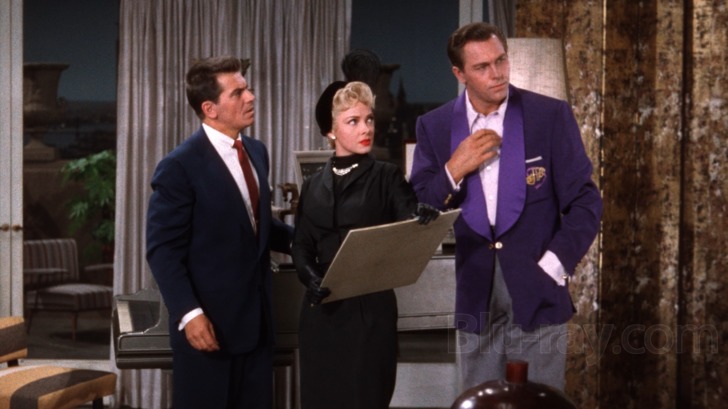
Kiss Me Kate was shot by Charles Rosher (Kismet and Show Boat ) in the process known as Ansco Color. The film was photographed at full frame and protected for a multitude of projection ratios, due to the transition currently underway in American movie theaters, with multiple formats competing for primacy. The intended ratio, according to director George Sidney, was 1.75:1, which is close to the 1.78:1 ratio on Warner's 1080p Blu-ray. The Blu-ray can be played in either 2D or 3D. In 2D, the disc reads as AVC-encoded; in 3D, the codec reads as MVC. The 3D restoration was performed by MPI, Warner's on-site facility, which previously restored 3D versions of Dial M for Murder and House of Wax. Note: All screen captures accompanying this review were taken in 2D mode. In either 2D or 3D, Kate's colors are bold and striking. Because the story is set in a make-believe theatrical world, there is always an array of bright hues before the camera. Even the opening scene in Fred Graham's apartment is quickly enlivened by the entrance of Lois in her pink and red cabaret outfit, and when Lois and Bill go to the theater's rooftop to argue about his gambling (in song), they are surrounded by colorful theatrical garb hanging to dry. They show-within-a-show is a kaleidoscope of multi-colored costumes, sets and lights. MPI's restoration has given the colors an intensity that hasn't been seen in Kate for many years. Detail is very good, but sharpness sometimes wavers, with the edges of objects and faces losing definition for a moment then coming back into focus. I suspect that this is an artifact of combining both 2D and 3D versions on one disc, because no such instability appeared in the 3D version. The film's grain pattern is extremely fine, but the grain on the 2D version is slightly coarser than on the 3D. The effect is most noticeable in faces and in lighter-colored backgrounds. Again, I suspect that a dedicated 2D version would allow for an improved viewing experience by permitting a finer resolution of the grain pattern in 2D—not that the 2D experience is bad; just that there's room for improvement. But it's in 3D that Kiss Me Kate truly shines, from the moment the MGM lion sticks his head out of the frame while he roars. Director George Sidney took every available opportunity to exploit the stereoscopic 3D process, including the three spinning placards that emerge from the screen with each word of the film's title. When Ann Miller performs "Too Darn Hot", she flings scarves and a bracelet at the camera (which occupies Fred's POV), establishing a motif that will recur throughout the film. Shots of the action on stage are sometime seen from the theater's balcony, with seat backs jutting up in the foreground. During the rooftop duet between Lois and Bill, Bill balances precariously on the ledge and, at one point, literally swings out into the audience. The opening of the show-within-a-show features glitter flung all around, a fire-breather, jugglers with bowling pins—one warm-up act after another hurling something off the screen. The backstage scenes, with their ladders, scaffolding, curtains and props, offer multiple opportunities for positioning theatrical cast and crew in different planes and at varying distances. Sharpness and detail in the 3D version are, if anything, slightly superior to the 2D, and the colors are just as vibrant and alluring. I showed Kiss Me Kate to a 3D fan I know whose taste runs exclusively to modern films, and while the experience didn't convert him to classic cinema, he was literally blown away by the quality of the 3D. He couldn't believe that anything this old could look so clear and three-dimensional.
Kiss Me Kate 3D Blu-ray Movie, Audio Quality 
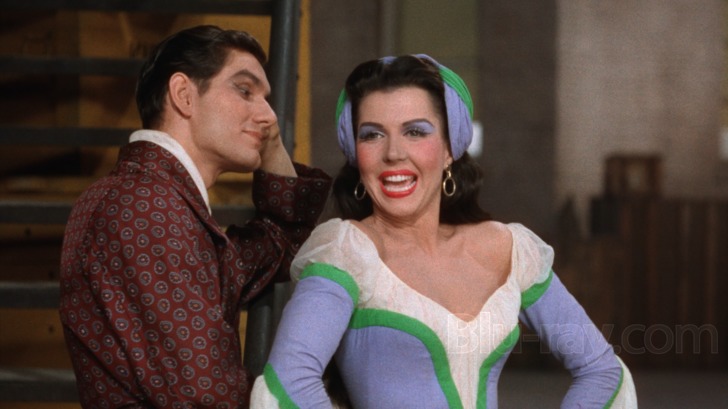
Kiss Me Kate was released in both stereo and mono, but the soundtrack for Blu-ray has been remixed in 5.1 and encoded in lossless DTS-HD MA. According to the press release, Warner returned to the original stems and magnetic masters for this remix, which accounts for the fullness and depth of the orchestral presence across the front soundstage and the clarity of the vocal reproduction. The latter is especially important when the song lyrics are as clever as Cole Porter's. (Unfortunately, the clarity also emphasizes the switch in tonal quality between studio-recorded singing and soundstage-recorded dialogue, but that is a limitation of the original soundtrack.) The stereo separation is subtle but definite. In a song like "Where Is the Life Which Late I Led?", Howard Keel struts back and forth while performing, and his voice follows him from left to right and back again. Kate has numerous critical sound effects—e.g., the beer mug that "Katherine" smashes onto the table to punctuate each verse of "I Hate Men"—and these register forcefully and effectively on this remixed track, without a harsh or tinny high end and with a good degree of bass extension. The balance between orchestra and singers seems just about right, and the remixing respects the film's period and does not try to "update" its sound.
Kiss Me Kate 3D Blu-ray Movie, Special Features and Extras 
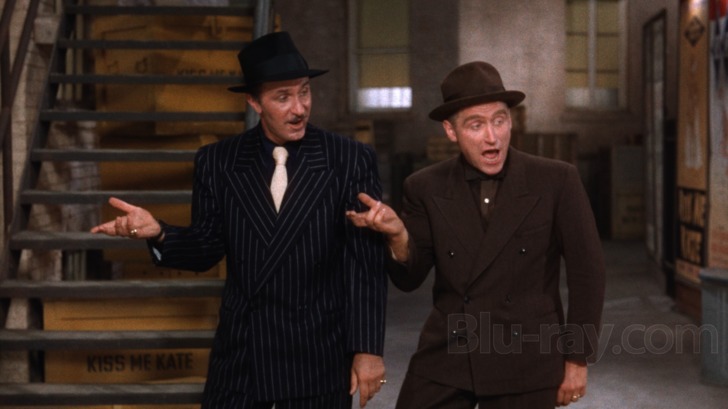
Warner previously released Kiss Me Kate on DVD in 2003 in a 2D-only edition. All of the DVD extras have been ported over to Blu-ray with the exception of a music-only track. New to Blu-ray is an MGM cartoon.
- Cole Porter in Hollywood: Too Darn Hot (480i; 1.33:1; 9:42): Ann Miller narrates this 2003 featurette on the making of the film, which includes interviews with Grayson, Keel, Rall and Whitmore.
- Mighty Manhattan, New York's Wonder City (480i; 1.37:1; 5:08): This MGM featurette celebrates Cole Porter's home town when New York was far different than it is today.
- Barney's Hungry Cousin (480i; 1.37:1; 6:42): A 1951 MGM cartoon featuring Barney Bear.
- Theatrical Trailer (480i; 1.37:1; 3:33): Laced with superlatives, this is a classic example of an older style of promotion.
Kiss Me Kate 3D Blu-ray Movie, Overall Score and Recommendation 
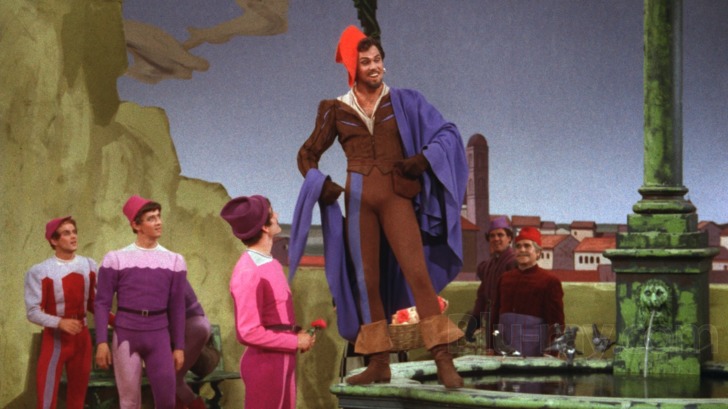
Translating a successful stage musical to the screen is a hit-and-miss proposition, with many more misses than hits. Kiss Me Kate is a very palpable hit, where all the artifice of cinema was effectively used to recreate the illusion of a live stage performance, right down to shots of the actors looking out into a theater filled with patrons. As we can now rediscover with this impressive Blu-ray presentation, 3D wasn't just an adjunct to the illusion, but an essential element. The extra depth gave space to the stage and immediacy to the battles (feigned and real) occurring there. It brought the movie audience into the live theater, where all the fun was happening. If you're a 3D fan, you'll want to acquire this disc just to see how well it could be done over sixty years ago. If you're a musical fan, this is the disc that may convert you to 3D. Either way, highly recommended.
Similar titles
Similar titles you might also like

The Band Wagon
1953

Guys and Dolls
Warner Archive Collection
1955

Bells Are Ringing
Warner Archive Collection
1960

Viva Las Vegas
50th Anniversary
1964

Calamity Jane
1953

Show Boat
Warner Archive Collection
1951

The Pirate
Warner Archive Collection
1948

The Boy Friend
Warner Archive Collection
1971

Victor/Victoria
1982

Hello, Dolly!
Fox Studio Classics
1969

On the Town
1949

Ziegfeld Girl
Warner Archive Collection
1941

The Pirates of Penzance
1983

Swing Time
1936

Oklahoma!
Rodgers and Hammerstein's Oklahoma!
1999

Miss Sadie Thompson 3D
Limited Edition to 3000
1953

Hit the Deck
Warner Archive Collection
1955

The Pajama Game
Warner Archive Collection
1957

Silk Stockings
Warner Archive Collection
1957

Neptune's Daughter
Warner Archive Collection
1949
